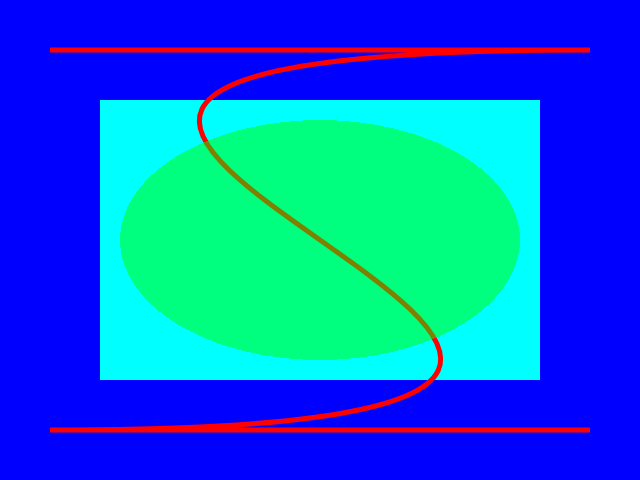Skia's Stable C API
===================
EXPERIMENTAL EXPERIMENTAL EXPERIMENTAL EXPERIMENTAL
DO NOT USE — FOR INTERNAL TESTING ONLY
Several issues hinder the development of a stable ABI (application
binary interface) for Skia:
1. Skia's C++ API changes a lot from version to version. Skia's two
largest clients, Android and Chrome, are kept up to date by the
Skia team, but that can not happen for every client.
2. Skia's headers will only match the compiled skia libraries if
configured identically.
To mitigate these two issues, Skia is experimenting with the
introduction of a C API. This will change more slowly than the C++
interface and, once API version 1.0.0 is announced,
backwards-incompatable changes will be avoided whenever possible.
Here is an example program that uses the C api. To try it out, get the file
[`skia-c-example.c`](./skia-c-example.c).
#include
#include "sk_data.h"
#include "sk_image.h"
#include "sk_canvas.h"
#include "sk_surface.h"
#include "sk_paint.h"
#include "sk_path.h"
static sk_surface_t* make_surface(int32_t w, int32_t h) {
sk_imageinfo_t info;
info.width = w;
info.height = h;
info.colorType = sk_colortype_get_default_8888();
info.alphaType = PREMUL_SK_ALPHATYPE;
return sk_surface_new_raster(&info, NULL);
}
static void emit_png(const char* path, sk_surface_t* surface) {
sk_image_t* image = sk_surface_new_image_snapshot(surface);
sk_data_t* data = sk_image_encode(image);
sk_image_unref(image);
FILE* f = fopen(path, "wb");
fwrite(sk_data_get_data(data), sk_data_get_size(data), 1, f);
fclose(f);
sk_data_unref(data);
}
void draw(sk_canvas_t* canvas) {
sk_paint_t* fill = sk_paint_new();
sk_paint_set_color(fill, sk_color_set_argb(0xFF, 0x00, 0x00, 0xFF));
sk_canvas_draw_paint(canvas, fill);
sk_paint_set_color(fill, sk_color_set_argb(0xFF, 0x00, 0xFF, 0xFF));
sk_rect_t rect;
rect.left = 100.0f;
rect.top = 100.0f;
rect.right = 540.0f;
rect.bottom = 380.0f;
sk_canvas_draw_rect(canvas, &rect, fill);
sk_paint_t* stroke = sk_paint_new();
sk_paint_set_color(stroke, sk_color_set_argb(0xFF, 0xFF, 0x00, 0x00));
sk_paint_set_antialias(stroke, true);
sk_paint_set_stroke(stroke, true);
sk_paint_set_stroke_width(stroke, 5.0f);
sk_path_t* path = sk_path_new();
sk_path_move_to(path, 50.0f, 50.0f);
sk_path_line_to(path, 590.0f, 50.0f);
sk_path_cubic_to(path, -490.0f, 50.0f, 1130.0f, 430.0f, 50.0f, 430.0f);
sk_path_line_to(path, 590.0f, 430.0f);
sk_canvas_draw_path(canvas, path, stroke);
sk_paint_set_color(fill, sk_color_set_argb(0x80, 0x00, 0xFF, 0x00));
sk_rect_t rect2;
rect2.left = 120.0f;
rect2.top = 120.0f;
rect2.right = 520.0f;
rect2.bottom = 360.0f;
sk_canvas_draw_oval(canvas, &rect2, fill);
sk_path_delete(path);
sk_paint_delete(stroke);
sk_paint_delete(fill);
}
int main() {
sk_surface_t* surface = make_surface(640, 480);
sk_canvas_t* canvas = sk_surface_get_canvas(surface);
draw(canvas);
emit_png("skia-c-example.png", surface);
sk_surface_unref(surface);
return 0;
}
 Example
-------
The following proof-of-concept workflow currently works on MacOS and
Ubuntu.
1. Compile Skia as a shared library:
cd ...../skia
bin/sync
gn gen out/Shared --args='is_official_build=true is_component_build=true'
ninja -C out/Shared
SKIA_LIB_DIR="${PWD}/out/Shared"
2. Compile, link, and run the example program:
cc -o skia-c-example -I include/c \
experimental/c-api-example/skia-c-example.c \
"$SKIA_LIB_DIR"/libskia.* -Wl,-rpath -Wl,"$SKIA_LIB_DIR"
./skia-c-example
[ $(uname) = Darwin ] && open skia-c-example.png
[ $(uname) = Linux ] && xdg-open skia-c-example.png
Example
-------
The following proof-of-concept workflow currently works on MacOS and
Ubuntu.
1. Compile Skia as a shared library:
cd ...../skia
bin/sync
gn gen out/Shared --args='is_official_build=true is_component_build=true'
ninja -C out/Shared
SKIA_LIB_DIR="${PWD}/out/Shared"
2. Compile, link, and run the example program:
cc -o skia-c-example -I include/c \
experimental/c-api-example/skia-c-example.c \
"$SKIA_LIB_DIR"/libskia.* -Wl,-rpath -Wl,"$SKIA_LIB_DIR"
./skia-c-example
[ $(uname) = Darwin ] && open skia-c-example.png
[ $(uname) = Linux ] && xdg-open skia-c-example.png
 Example
-------
The following proof-of-concept workflow currently works on MacOS and
Ubuntu.
1. Compile Skia as a shared library:
cd ...../skia
bin/sync
gn gen out/Shared --args='is_official_build=true is_component_build=true'
ninja -C out/Shared
SKIA_LIB_DIR="${PWD}/out/Shared"
2. Compile, link, and run the example program:
cc -o skia-c-example -I include/c \
experimental/c-api-example/skia-c-example.c \
"$SKIA_LIB_DIR"/libskia.* -Wl,-rpath -Wl,"$SKIA_LIB_DIR"
./skia-c-example
[ $(uname) = Darwin ] && open skia-c-example.png
[ $(uname) = Linux ] && xdg-open skia-c-example.png
Example
-------
The following proof-of-concept workflow currently works on MacOS and
Ubuntu.
1. Compile Skia as a shared library:
cd ...../skia
bin/sync
gn gen out/Shared --args='is_official_build=true is_component_build=true'
ninja -C out/Shared
SKIA_LIB_DIR="${PWD}/out/Shared"
2. Compile, link, and run the example program:
cc -o skia-c-example -I include/c \
experimental/c-api-example/skia-c-example.c \
"$SKIA_LIB_DIR"/libskia.* -Wl,-rpath -Wl,"$SKIA_LIB_DIR"
./skia-c-example
[ $(uname) = Darwin ] && open skia-c-example.png
[ $(uname) = Linux ] && xdg-open skia-c-example.png